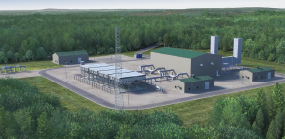This report provides the results of an evaluation of the units impacted by national regulations to control hazardous air pollutants (HAPs) from natural gas-fired combustion turbines and reciprocating internal combustion engines (IC engines). Impacts were estimated using the Engine and Turbine Database (ETDB), an industry database developed through support of the Gas Research Institute (GRI), the Pipeline Research Council International (PRCI), and the Interstate Natural Gas Association of America (INGAA). Impacts for combustion turbines were estimated for the following regulations:
- Maximum Achievable Control Technology (MACT) standards for combustion turbines >1 megawatt (MW) located at major-source facilities, and
- Residual risk standards for combustion turbines located at major-source facilities.
Impacts for IC engines were estimated for the following regulations:
- MACT standards for IC engines >500 horsepower (HP) located at major-source facilities,
- MACT standards for IC engines £500 HP located at major-source facilities,
- HAP regulations for IC engines located at non-major facilities, known as area sources, and
- Residual risk standards for IC engines located at major-source facilities.
Key findings of this review for combustion turbines include:
- Under the final Combustion Turbine MACT standard, all new combustion turbines > 1 MW will be subject to MACT upon startup. The final standard removed requirements for approximately 58 existing lean premix combustion turbines located at major-source facilities, in response to comments received on the proposed Turbine MACT.
- EPA is currently considering a petition to delist combustion turbines from the MACT process. If the petition were successful, EPA would withdraw the final Turbine MACT for gas-fired combustion turbines and no gas-fired combustion turbines would be subject to MACT requirements. EPA plans to propose the petition later this year (2003), with a final decision approximately one year later (2004).
- If the petition for delisting is not successful, and the final Turbine MACT is implemented, EPA is required to evaluate residual risks for combustion turbines within eight years of the final Turbine MACT. The residual risk standard for the Combustion Turbine MACT would apply to 247 existing turbines located at major-source facilities. EPA has not yet made a determination that additional reductions are necessary for combustion turbines. If EPA determines that additional reductions are necessary, controls may be required for existing turbines, which are not subject to controls under the major-source MACT standard. If a 1,000 HP size applicability criterion were established, 239 existing turbines would be subject to regulation. If a 5,000 HP applicability criterion were established, 139 existing turbines would be subject to regulation. Residual risk rules for combustion turbines are due by 2011.
Key findings of this review for IC engines include:
- The MACT standard for IC engines >500 HP will impact approximately 302 existing 4-stroke rich burn (4SRB) engines >500 HP located at major-source facilities. Initial notification of MACT applicability must be filed for the existing 4SRB engines in 2004. The existing 4SRB engines will be subject to MACT emission limitations in 2007. In addition, new 4SRB engines >500 HP will be subject to MACT upon startup.
- The MACT standard for IC engines >500 HP, as proposed, would not impact existing 4-stroke lean burn (4SLB) engines. However, if EPA revises the standard, based on comments submitted by the State of Wyoming, the MACT standard would impact approximately 696 existing 4SLB engines >500 HP located at major-source facilities. EPA has not yet made a determination regarding any revision of the requirements for existing 4SLB engines. If existing 4SLB engines were subject to MACT, initial notification would be required in 2004 and the affected engines would be subject to MACT emission limitations in 2007. In addition, new 4SLB engines >500 HP will be subject to MACT upon startup.
- The MACT standard for IC engines >500 HP, as proposed, would not impact existing 2-stroke lean burn (2SLB) engines. No comments have been submitted regarding EPA’s decision for these engines. Therefore, no requirements are anticipated for existing 2SLB engines. New 2SLB engines >500 HP will be subject to MACT upon startup.
- The MACT standard for IC engines £500 HP may affect up to 425 existing IC engines £500 HP that are located at major-source facilities. Most of these small engines are 4SRBs. The impacts depend largely on the size applicability criterion that EPA selects. If the size applicability criterion is 200 HP, approximately 214 units would be subject to MACT, mostly 4SRBs. Affected existing engines would be subject to MACT emission limitations in 2010. All new engines above the size cutoff criterion, and located at facilities that are major sources of HAP emissions, will be subject to MACT upon startup.
- For the area-source standard, the MACT standard may impact as many as 1,906 existing IC engines. EPA has not yet proposed this standard and impacts will be affected by decisions on size applicability criteria and whether IC engines are regulated nationwide or only in urban areas. Assuming nationwide applicability and a 200-HP size applicability criterion, approximately 1500 existing IC engines would be impacted. Affected existing engines would be subject to HAP emission limitations in 2010. All new engines above the size applicability criterion, and located at facilities that are area sources of HAP emissions, will be subject to HAP emission limitations upon startup.
- The residual risk standard for the IC Engine MACT may impact up to 3,923 existing IC engines located at major-source facilities. EPA has not yet made a determination that additional reductions are necessary for IC engines. If EPA determines that additional reductions are necessary, controls may be required for existing lean-burn engines, which are not subject to controls under the major-source MACT standard. Most of the units potentially impacted are existing 2SLB engines. If a 500 HP size applicability criterion were established, over 3,000 lean-burn IC engines would be subject to regulation. If a 2,000 HP size applicability criterion were established, 1300 lean-burn engines would be subject to regulation. The residual risk rules for IC engines are due by 2012.



